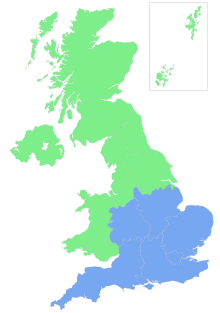- North–South divide in the United Kingdom
-
In Great Britain, the term North–South divide refers to the economic and cultural differences between Southern England and the rest of Great Britain (Northern England, Wales and Scotland). The divide cuts through the English Midlands. Sometimes, the term is widened to include the whole United Kingdom, with Northern Ireland included as part of "the North".
In political terms, the South, and particularly the South-East (outside inner London), is largely centre-right, and supportive of the Conservative Party, while the North (particularly the towns and cities) is generally more supportive of the Labour Party as well as, in Scotland, the SNP. Support for the Liberal Democrats, and for many of the smaller parties, is generally more equally spread out.There is some criticism of this analysis in the West Country which has consistently provided a solid base for the Liberal Democrats, and also in places (particularly parts of Bristol, Devon, and Cornwall) suffers the same economic problems as the North.
This is the line that separates upland from lowland Britain, the hills from the most fertile farmland, areas invaded by Vikings from those first colonised by Saxons. Numerous facts of life divide the North from the South – there is a missing year of life expectancy north of this line.[citation needed]
Contents
Existence
The North-South divide is not an exact line, but one that can involve many stereotypes, presumptions and other impressions of the surrounding region relative to other regions.
The existence of the North-South divide is fiercely contested. Some sources claim it exists but also that it is even expanding. For example, a report in 2001 found that North East England, North West England and Scotland had poorer health levels than South.[1]
The same data have been interpreted otherwise to indicate only a very small difference.[2]
Indeed, results are highly dependent on the categories chosen for evaluation. As a generalisation, the following tend to indicate that there is some sort of north-south divide:
- Health conditions, which are generally seen as being worse in the north.[3][4] though spending on health care is higher [5]
- House prices, which are higher in the south, particularly the south-east.[6]
- Earnings, which are higher in the south and east.[7]
- Government expenditure, which is higher (both in gross terms and relative to tax revenues) in the north.[8]
- Political influence.[9]
However, many middle-class and affluent areas are located near Manchester, Leeds and Edinburgh. A report into wealth by Barclays Bank also highlighted the anomaly that the second-wealthiest parliamentary constituency after Kensington and Chelsea is actually Sheffield Hallam.
This has led some commentators to suggest that other divisions, such as class[10] or ethnicity might be more important.[11]
There is also controversy as to what constitutes the South given that it extends much farther horizontally than the North of the country; some commentators have placed the West Country (in this case, Bristol,[12]Somerset, Devon and Cornwall) into a region of its own because the poverty in some of these areas is often as widepsread as it is in the North, and political support is also focused on the usually widespread Liberal Democrats.
Politics
The North has been generally perceived as being supportive of Labour as well as in Scotland the SNP and the South being generally supportive of the Conservatives. During the 1980s, Labour councils in the North were often openly dismissive of any orders from the Thatcher government. Examples include Liverpool under the Militant tendency and Sheffield under David Blunkett. Furthermore, after the 2010 General election, the Conservatives held only one seat in Scotland and none in the major cities of Newcastle, Manchester, Glasgow, Edinburgh, Hull, Leeds, Sheffield and Liverpool, all of which were dominated by Labour.
In addition there is a general resentment towards the perceived dominance of South in British politics. With the government based in London the perception has been created that the government prioritises the south, this is combined with the perceived economic weakness of the north. This has most notably manifested itself with calls for regional parliaments to dilute the dominance of the south and create their own representation. Whilst these calls have been weaker in Northern England, they were significantly strong in Scotland and Wales to pass the vote for a devolved parliaments.
See also
- North-South divide
- North-South divide (England)
- North-South divide (Wales)
- Scottish Highlands and Scottish Lowlands
- North Britain and South Britain
- Lloegyr
Footnotes
- ^ Doran, Tim; Drever, Frances; Whitehead, Margaret (1 May 2004). Is there a north-south divide in social class inequalities in health in Great Britain? Cross sectional study using data from the 2001 census. http://bmj.bmjjournals.com/cgi/content/abstract/328/7447/1043?ijkey=76a2ead76e6828d38e96cd46ded8f235930215ca&keytype2=tf_ipsecsha. Retrieved 2006-07-16.
- ^ Bland, J Martin (3 July 2004). "North-south divide in social inequalities in Great Britain". British Medical Journal. http://bmj.bmjjournals.com/cgi/content/full/329/7456/52. Retrieved 2006-07-16.
- ^ Carvel, John (11 November 2005). "Wide life expectancy gap between rich and poor". London: The Guardian. http://www.guardian.co.uk/northsouth/article/0,,1640082,00.html. Retrieved 2006-07-16.
- ^ Meikle, James (6 July 2005). "Cancer atlas reveals north-south divide". London: The Guardian. http://www.guardian.co.uk/britain/article/0,,1522036,00.html. Retrieved 2006-07-16.
- ^ . http://www.reform.co.uk/Research/ResearchArticles/tabid/82/smid/378/ArticleID/1217/reftab/161/Default.aspx.
- ^ "UK House Prices". BBC News. 8 May 2006. http://news.bbc.co.uk/1/shared/spl/hi/in_depth/uk_house_prices/html/houses.stm. Retrieved 2006-07-16.
- ^ Carvel, John (10 November 2005). "North-south, east-west wealth divides in survey". London: The Guardian. http://www.guardian.co.uk/northsouth/article/0,,1638884,00.html. Retrieved 2006-07-16.
- ^ "The REAL north-south divide How South East bankrolling Britain". London: The Daily Mail. 12 October 2007. http://www.dailymail.co.uk/news/article-487058/The-REAL-north-south-divide-How-South-East-bankrolling-Britain.html.
- ^ Elliott, Larry (5 July 2004). "The United Kingdom of London". The Guardian. http://www.guardian.co.uk/northsouth/article/0,,1638884,00.html. Retrieved 2006-07-16.
- ^ Ahmed, Kamal (10 November 2002). "Britain's class divide starts even before nursery school". London: The Observer. http://observer.guardian.co.uk/education/story/0,12554,837171,00.html. Retrieved 2006-07-16.
- ^ "Making a difference: Tackling poverty - a progress report" (PDF). Department for Work and Pensions. March 2006. http://www.dwp.gov.uk/publications/dwp/2006/poverty/tackling-poverty.pdf. Retrieved 2006-07-16.
- ^ Clark, Dave (15 July 2011). "Mr". http://www.bristol.gov.uk/ccm/cms-service/stream/asset/?asset_id=36498092. Retrieved 15 July 2011.
Wikimedia Foundation. 2010.

